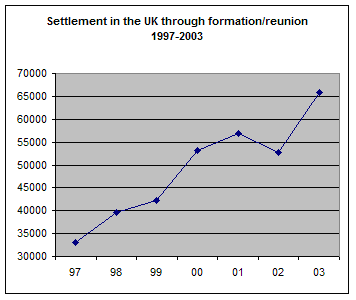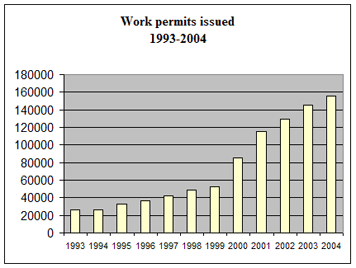Immigration: Will it increase or decrease?
31 March, 2003
Summary1. The government are seeking to downplay their own population forecasts by suggesting that the policy measures they have proposed will cause migration to fall. An examination of the underlying trends and the government's proposed measures suggests that the forecasts are much more likely to be an underestimate.
Detail
2. Recognising public concern at the impact of the present massive levels of immigration, the government are starting to downplay their own official population projections. These show very clearly that immigration will add five million - the equivalent of five times the population of Birmingham - to the population of England by 2031. Yet, on the Today Programme on 22 March, the Minister for Immigration said that he did not expect this to happen. Other proponents of immigration talk vaguely to the effect that numbers can fall as well as rise. This paper examines the robustness of the official projection.
3. The Government Actuary's principal population shows that the population of the UK is projected to increase by 6.1 million between 2003 and 2031. It is based on an assumption that net migration will average 130,000 a year. 5.2 million of this increase is due to immigration, i.e. immigrants themselves and their descendants [1].
4. Net migration has, in fact, averaged rather more than this in recent times. In the most recent 6 years (up to 2003) for which there is data, average net migration has been 157,000 p.a. [2]
5. Neither the actual figures nor the Government Actuary's assumption allows for illegal immigration - the level of which is not known but which the government thinks runs into a total of several hundred thousands. Approximately 50,000 people a year are detected attempting to enter Britain illegally. Nobody knows how many succeed.
6. So, is it likely, based on the government's past record and the policies recently announced in its recent "Five Year Strategy", that net migration will decrease?
7. There are three principal long-term migration streams - asylum, family formation/reunion and work-related migration.
8. The number of people seeking asylum in the UK reduced from 103,000 in 2002 to 60,000 in 2003 and to 40,000 in 2004. Over the same period removals were 14,000, 18,000 and 15,000 respectively. Net migration of asylum seekers (i.e. new claimants less removals) therefore decreased from about 89,000 in 2002 to 42,000 in 2003 and to 25,000 in 2004. However, despite the steep fall between 2002 and 2003 there was little change to the overall net migration figure - it stood at 153,000 in 2002 and went down to only 151,000 in 2003.
9. The reason is that the other two migration streams - family formation/reunion and work-related migration continue to rise. Family formation is on a continuing upward trend as demonstrated by the following settlement figures (a delayed measure of family formation/reunion migration as migrants are not immediately given settlement rights). [3]

10. Similarly the number of work permits issued has rapidly increased as shown below:[4]

11. Even if the number of work permits issued now starts to level out another major source of work-related migration started in 2004 - namely migration from the Eastern European countries which recently acceded to the EU. 130,000 workers registered from these countries in the period from May to December 2004 inclusive [5]. Some will have returned home but the number staying will be considerable.
12. It seems unlikely therefore that there will have been any reduction, in 2004 at least, in net migration to the UK. On the contrary - there is likely to be an increase but we will not know until the figures are published in November 2005. In the longer term, assuming new asylum claims stay at around 40,000 a year and that over 80% stay in the UK irrespective of the validity of their claim, we are unlikely to see further falls in net migration resulting from asylum.
13. The government is proposing to make little change to rules governing family formation/reunion and work permit employment [6]. Migration from the Eastern Europe states may slacken off in time but other countries, Romania and Bulgaria in the next wave and then some of the Balkan states and eventually Turkey are likely to join the EU.
14. We conclude, therefore, is that there is very little prospect of net migration declining from the present massive levels in the foreseeable future.
Footnotes
| [1] | Source: GAD comparison of principal population projection and natural change (no migration) population projection. |
| [2] | ONS: International Migration - Series MN29. |
| [3] | Home Office publications HOSB11/02 and HOSB 12/04. Figures exclude accompanying dependants of work permit holders and asylum seekers. |
| [4] | Sources: ONS: Labour Market trends November 2003 - Work Permits and foreign labour in the UK: a statistical review by James Clarke and John Salt, Migration Research Unit, UCL and Hansard 12 July 2004 Column 988W and 2004 figure from the Home Office (email to Migration Watch) |
| [5] | Home Office Press release 036/2005 |
| [6] | see Migration Watch report on the government's proposals for work permits. In relation to family formation the proposals, although welcome, address only one aspect of chain migration - not the principal issue of marriages to foreign spouses. The proposals in relation to work permits are essentially a restructuring of the current arrangements (see MigrationWatch briefing paper 3.1 A points system for Work Permits? for a full evaluation (click here) |
